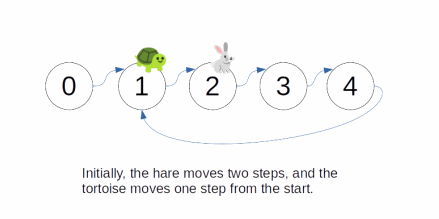Two Pointer: Cycle Finding
Linked List Cycle
Given a linked list with potentially a loop,
determine whether the linked list from the first node contains a cycle in it.
For bonus points, do this with constant space.
Parameters
nodes: The first node of a linked list with potentially a loop.
Result
Whether there is a loop contained in the linked list.
Example 1
Input:
0 -> 1 -> 2 -> 3 -> 4
^ |
| - - - - - - -
Output: true
Example 2
Input:
0 -> 1 -> 2 -> 3 -> 4
Output: false
Constraints
1 <= len(nodes) <= 10^5
class Node {
constructor(val, next = null) {
this.val = val;
this.next = next;
}
}
function hasCycle(head) {
let fast = head;
let slow = head;
while (slow && fast) {
fast = fast?.next?.next;
slow = slow?.next;
if (!fast || !slow) break;
if (fast === slow) return true;
}
return false;
};

Explanation
- If a linked list has no loop, then when we iterate through the list, we will eventually reach the end of the list
- at which point we can simply return
- However, the challenge is figuring out how to terminate the program if it finds a loop
- Otherwise the program would go on forever
- A simple solution would be to use a set to store the information
- We store all the nodes we have been through and check if we have been there each time we move
- However, a set is not constant memory, and there might be issues with hashing and whatnot
- Introducing
Floyd's Cycle Finding Algorithmalso known as theTortoise and Hare Algorithm- The idea is to have two pointers, the fast pointer (or "hare") moves at double speed of the slow pointer (or "tortoise")
- Each cycle, the tortoise moves once and the hare moves twice
- The idea is that since the cycle must have integer size
- when the tortoise and the hare are both in the cycle
- their distance difference must also be an integer
- Then, each cycle, because of their speed difference
- the distance between them constantly reduces until they meet
- in which case we know there is a cycle
- However, if there is no cycle, they will never meet because the speed of the hare is always faster
- Time Complexity:
O(n)- Technically
O(n/2)but again we factor out the constant and we are left with linear time - Worst case we have,
O(2n)as the small pointer moves around the entire array once - Either way we have
O(n)time complexity
- Technically